27 February 2022
The American space agency NASA has launched a new instrument designed to collect data on volcanic activity and air quality.
NASA said in a statement it hopes the small orbiting instrument could help predict a volcanic eruption before an explosion happens.
The device recently launched aboard a Northrop Grumman Cygnus spacecraft. Cygnus arrived at the International Space Station on February 21, carrying a large load of supplies and scientific experiments.

This file photo shows a Northrop Grumman Cygnus spacecraft in the grip of the International Space Station's Canadarm2 robotic arm. (Photo Credit: NASA)
NASA calls the instrument NACHOS, which stands for Nanosat Atmospheric Chemistry Hyperspectral Observation System. It contains imaging sensors designed to identify gases like sulfur dioxide and nitrogen dioxide. The presence of those gases can signal possible volcanic activity.
NACHOS was built to observe trace gases in areas as small as 0.4 square kilometers. The six-kilogram instrument is set to be deployed in May. It will operate attached to a CubeSat, a small satellite weighing less than 10 kilograms. NASA says NACHOS will observe from about 480 kilometers above Earth's surface.
NASA considers the instrument a "prototype," meaning its operations and observations will be studied during its orbit, which is expected to last one year. The agency says NACHOS will be "the smallest, highest resolution space-based instrument" ever sent to observe atmospheric gases.
Steve Love is a scientist with the Department of Energy's Los Alamos National Laboratory, which is cooperating with NASA on NACHOS. He said in a statement that "a dormant volcano just waking" may give off sulfur dioxide before there is any observable volcanic activity.
"That gives us a chance to identify a potentially erupting volcano before it actually blows," Love said.
Such a device could help emergency officials take early measures to protect citizens and property from volcanic eruptions. But NASA says NACHOS can help scientists on Earth in other ways, too.
The instrument can also be used to observe gas levels from natural and human-made sources that can be harmful to humans. One gas that NACHOS will search for is nitrogen dioxide, which often comes from burning fossil fuels. Identifying the gas could help scientists find areas with high levels of harmful pollution.
"When we recognize that these gases are present and can localize their sources ... we have the opportunity to take action and minimize negative health outcomes," Love said.
In the past, NASA has created satellites to observe these kinds of gases. But Love said those traditionally required high-resolution images and sensitive instruments that were costly to produce and operate.
Smaller devices, like NACHOS, could enable a wider use of the technology at a much lower cost. If it proves successful, the technology could also be used in Earth-based systems, NASA says.
"More power and less weight set NACHOS apart and make it an excellent candidate for future atmospheric trace gas missions," Love said.
NASA says after NACHOS is deployed, Love and his team will spend three months testing its systems and getting the instrument fully operational.
During its yearlong mission, the team will study the instrument's performance to learn whether the technology should be further developed.
A second NACHOS instrument, NASA, said, will be deployed to low-Earth orbit in the winter of 2022 as part of a U.S. Department of Defense program.
I'm Bryan Lynn.
Bryan Lynn wrote this story for VOA Learning English, based on reports from NASA.
We want to hear from you. Write to us in the Comments section, and visit 51VOA.COM.
_____________________________________________________________
Words in This Story
eruption – n. the bursting out of material from a volcano
trace – n. a small amount of something
prototype – n. an original or first model of something from which others are copied or developed
dormant – adj. not presently active or developing, but possibly active in the future
fossil fuel – n. fuels such as coal, oil, or natural gas formed in the earth from dead plants or animals
opportunity – n. a situation in which it is possible for a person to do something
minimize – v. to reduce to a very low level
negative – adj. bad or damaging
mission – n. an important project or trip, especially involving space travel